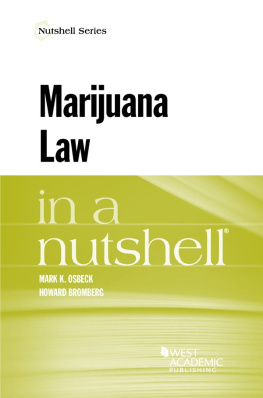Thank you for buying this ebook, published by Hachette Digital.
To receive special offers, bonus content, and news about our latest ebooks and apps, sign up for our newsletters.
Copyright 2015 by William J. Bennett and Robert A. White
Cover design by Jody Waldrup
Cover photography of marijuana leaf by Getty Images, Inc.
Cover copyright 2015 by Hachette Book Group, Inc
All rights reserved. In accordance with the U.S. Copyright Act of 1976, the scanning, uploading, and electronic sharing of any part of this book without the permission of the publisher constitute unlawful piracy and theft of the authors intellectual property. If you would like to use material from the book (other than for review purposes), prior written permission must be obtained by contacting the publisher at permissions@hbgusa.com. Thank you for your support of the authors rights.
Center Street
Hachette Book Group
1290 Avenue of the Americas
New York, NY 10104
centerstreet.com
twitter.com/centerstreet
First ebook edition: February 2015
Center Street is a division of Hachette Book Group, Inc.
The Center Street name and logo are trademarks of Hachette Book Group, Inc.
The Hachette Speakers Bureau provides a wide range of authors for speaking events. To find out more, go to www.hachettespeakersbureau.com or call (866) 376-6591.
The publisher is not responsible for websites (or their content) that are not owned by the publisher.
The authors gratefully acknowledge the permission to reprint the chart that appears in the Introduction and the articles that appear in the appendix from:
The New England Journal of Medicine, Nora D. Volkow, Ruben D. Baler, Wilson M. Compton, and Susan R. B. Weiss, Adverse Health Effects of Marijuana Use, 370, 22192227. Copyright 2014 Massachusetts Medical Society. Reprinted with permission from Massachusetts Medical Society.
The New England Journal of Medicine, Adverse Health Effects of Marijuana Use, 371, 878879. Copyright 2014 Massachusetts Medical Society. Reprinted with permission from Massachusetts Medical Society.
The authors would also like to thank:
Tom Gorman, Director of the Colorado HIDTA (High Intensity Drug Trafficking Area), for his permission to reprint the charts that appear .
Ben Cort for his permission to reprint the photos that appear .
The chart that appears comes from the National Institute on Drug Abuse (NIDA).
Additional photo permissions:
Bob Berg/Getty Images;
Seth McConnell/Getty Images;
Bob Berg/Getty Images;
Justin Sullivan/Getty Images:
Photos , copyright 2015 by Hachette Book Group, Inc.
ISBN 978-1-4555-6071-4
E3
We dedicate this book to the men and women who serve on the front lines in the war on drugs at the local, state, and federal level. Their hard work, courage, and sacrifices deserve our gratitude and respect.
T ogether, we would like to thank a talented and devoted group of friends and experts whose thoughts, research, and guidance we could not have done this book without: Dr. Robert DuPont, Dr. Herbert Kleber, Dr. Christian Thurstone, Dr. David Murray, Dr. John Walters, Dr. Casey Wolf, Dr. Bertha Madras, Christopher Beach, Noreen Burns, Alexandra Datig, Ben Cort, Thomas Gorman, Michael Tremoglie, and Steve and Debbie Moak. They all have been at this a long time and, to the degree we can turn around this cultural tide, the nations thanks will go to all of them.
We would like to express special appreciation to Seth Leibsohn, who has been an integral part of this project from the very beginning.
We also would like to thank Kate Hartson and her team at Hachette Books.
Of course, the love and support of our wives, Elayne and Ginnie, have been invaluable to this project.
W e are at a curious, as well as critical, moment in our country. Just when we are spending more than ever on early childhood education (and many are arguing for even more spending), just when we are debating the intellectual and motivational needs of our present and future work force, just as we are concerned about unemployment numbers that are too high (especially in the youth and young adult population), just as we are unveiling a new experiment on universal health care coverage, and just as we are condemning other products deemed unhealthy, like sugars and trans fats, we areat the same exact timemoving in fact and opinion toward more and more marijuana legalization. We are spending money and political capital on strengthening the health, education, and productivity of our populace, yet society believes it appropriate to push for greater availability of a drug that hinders, and negatively affects (perhaps dramatically), those very efforts.
Over the past several years, as public opinion has moved toward greater acceptance of marijuana, an increasing body of scientific evidence has documented the multiple adverse effects of marijuana use. These serious health issues are detailed in an excellent article produced by the National Institute on Drug Abuse and published in the June 2014 issue of the New England Journal of Medicine. We believe this article should be read by everyone, particularly proponents of legalization, and so we have included it in our appendix. The negative consequences of marijuana legalization, particularly those experienced by adolescents, are too crucial to ignore. As you can see from Table 1 of that article, a variety of short- and long-term effects should give pause to anyone who might believe that smoking marijuana is harmless.

Increased Knowledge of the Dangers

On an almost weekly basis, medical researchers, aided by advanced technology not available decades ago, are expanding our knowledge of the negative health consequences of smoking marijuana. As we will discuss in more detail in later chapters, more than smoking tobacco or drinking alcohol, smoking marijuana can damage the heart, lungs, and brain. Moreover, it immediately impairs cognitive abilities and motor coordination, interfering with the smokers judgment, driving skills, and other basic abilities. Normal development of the adolescent brain is at particularly high risk. Smoking marijuana deposits more tar into the lungs than smoking a cigarette, and there are numerous cancer-causing chemicals in marijuana. There is nearly a fivefold increase in the risk of heart attack in the first hour after smoking marijuana. It is a bitter irony that as our knowledge increases regarding the harm that smoking marijuana does to our health, public perception of those injuries decreases. It is our purpose in this book to inform an uninformed, and sometimes misinformed, public about the true risks of legalization.

















